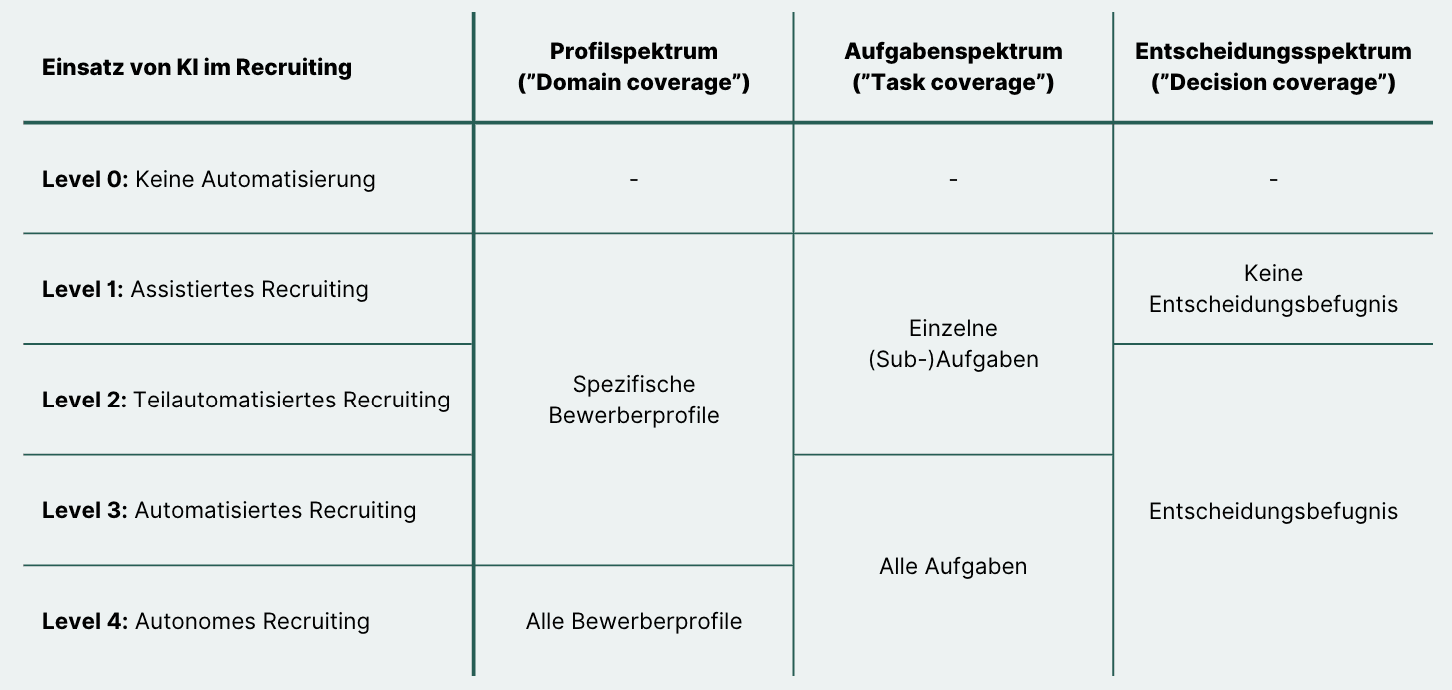The development of artificial intelligence in recruiting: the 4-level model
Table of contents
Shortage of skilled labour, changes in individual preferences, relevance of new forms of work: The HR market is undergoing radical change. In view of numerous pull factors, the sector has developed into an employee market. For recruiters, this means understanding and responding to the needs and wishes of talents more than ever before. Artificial intelligence (AI) can help with this. As is already happening in many sectors, AI is realising huge efficiency gains. Better late than never: now it's the HR sector's turn. We have developed the 4-level model of AI in recruiting to categorise the development status and degree of application of AI systems.
Deciphering talents
When we look at the most important resource of an organisation - the people themselves - we quickly realise that talents are no longer interested in a mere job description, but in values and corporate culture. Studies show that the five most important job satisfaction factors are purely cultural. Factors such as the relationship with team colleagues or further training opportunities are essential and therefore a strong differentiator for organisations.
Nevertheless, the corporate culture and the values practised have so far had little relevance on prominent recruitment portals. A job advert offers little more information than the job title or a generic description of the role.
With this in mind, it is hardly surprising that 70% of all employees in Germany are thinking about changing jobs due to their dissatisfaction. And that's just the beginning. Forecasts show: Gen Z will end up with an average of 20 different employers over the course of their career.
So how is it possible to significantly increase employee loyalty? How can individual preferences be catered for? And in particular: How do you attract talents in the 21st century? Anyone facing up to these challenging questions should be courageous. Because we have great opportunities to inspire and retain talents and grow together: through artificial intelligence.
AI systems as game changers
Everyone is talking about AI today, but the origins of AI systems lie around 80 years in the past: the term AI was coined in 1956, the first chatbot was born in 1966, IBM's Deep Blue beat the world chess champion in 1997 and the breakthrough in deep learning came in 2012: AlexNet not only won the ImageNet Challenge, it dominated it. At the latest since the commercialisation of ChatGPT by OpenAI, AI has been on everyone's lips and is becoming a tool that is simple and can be used by anyone.
Many industries are realising significant increases in efficiency thanks to artificial intelligence. The fintech sector, for example, has an AI adoption rate (i.e. the integration rate of AI systems in organisations) of well over 50 percent. The global AI market in the automotive industry is growing at a CAGR of 39.8 percent to USD 15.9 billion by 2027. The result of these successful sectors: productivity increases of 60 percent and cost savings of 20 percent.
The AI adoption rate in the HR sector, on the other hand, is where the fintech sector was almost ten years ago. One example in recruiting: job advertisements, career fairs and referrals are still among the top recruiting channels today. It is easy to see that these channels are mostly far removed from the use of innovative technologies, not to mention AI systems.
Human resources and recruiting are the origin of all value creation in organisations. However, it is precisely there - at the origin of economic value creation - that the potential of AI systems is not even rudimentarily utilised. There are various reasons for this. One of them is that automation in recruiting is anything but trivial. Quantifying soft factors such as corporate culture and values is particularly challenging and is subject to constant change and continuous development.
The 4 levels of AI in recruiting: a systematic categorisation
AI often seems intangible. This lack of tangibility repeatedly leads to uncertainty or even fear. In order to provide a realistic picture of AI systems and a clear understanding of the state of development and application, we (Empion) have developed the four levels of AI in recruiting.
In a way, the 4-level model is an homage to the classification of the automotive industry, i.e. the 5 AI levels of autonomous driving. Similar to the financial sector, the automotive industry is a pioneer in the research and application of AI systems. This is because autopilots and autonomous parking solutions have already been ready for use for several years.
The 4-level model of AI in recruiting reflects the technological progress in recruiting, starting at level 0 (no use of AI systems) through to level 4 (autonomous recruiting). We differentiate between three dimensions: Task Coverage (the task spectrum), Domain Coverage (the candidate profile spectrum) and Decision Coverage (the decision spectrum). Figure 1 summarises the 4-level model.
Level 0: No automation Level 0 has no application of artificial intelligence. A classic case would be, for example, recruiting via a careers fair, via recommendations or usually also via traditional job boards.
Level 1: Assisted recruiting In AI-assisted recruiting, AI systems are used to provide support in a very limited context. It takes on individual subtasks in the recruiting process for specific applicant profiles, guided and monitored by the recruiter. However, the recruiter makes all decisions. An example of Level 1 is the use of large natural language models (e.g. ChatGPT) in active sourcing (direct approach of candidates) or the reading of CVs for data maintenance in the ATS (applicant management system).
Level 2: Partially automated recruiting In semi-automated recruiting, individual tasks for specific applicant profiles are completely taken over by AI. In these clearly defined areas, the AI also has decision-making authority. In other words, it makes certain decisions and initiates a defined next step in the process. For example, AI can take over the screening of applicants and automatically send rejections for unsuitable applicants. The recruiter can intervene at any time if the system requests it. However, as in level 1, the human still makes the decisions.
Level 3: Automated recruiting In contrast to level 2, the AI systems can work completely on their own for specific applicant profiles. This means that they can take on not just one, but all tasks in the application process, e.g. advertising applications, pre-selecting talents, communicating with applicants and preparing for recruitment. In most scenarios, human interaction is no longer required. However, there are limitations. Automation is limited to specific applicant profiles (e.g. controller or account manager).
Level 4: Autonomous recruiting In the final stage, autonomous recruiting, AI systems can perform all types of tasks for all applicant profiles fully automatically and make the associated decisions. And without human interaction. In concrete terms, this means that AI systems are able to carry out the entire process from recruitment planning to the first day of work. They can also be used accordingly in employee development.

The definition of the levels also shows the difference to the 5-level model of autonomous driving: a time-critical system. Decisions must be made immediately, otherwise an accident may occur. The integration of the speed of human interaction as a dimension in the model is therefore much more relevant. Specifically, a distinction must be made as to whether the driver has to monitor every process step or is only on standby. Recruiting is comparatively less time-critical because: Emails to applicants can also be sent five minutes later, for example (should the AI system encounter an unknown situation). Therefore, the distinction between the speed of human interaction is not decisive for the use of AI in recruiting.
AI in recruiting is still in its infancy
The social debate surrounding AI systems in Germany is mostly extreme, as we keep hearing about scenarios that philosophise about AI systems taking over power. These fears are by no means new and are usually linked to waves of positive hype about AI systems.
But what is the reality of AI in recruitment?
The use of AI systems in recruiting is still in its infancy. Specifically: between level 0 and 1. It can be assumed that many organisations are nowhere near level 1. This categorisation shows the open potential. Nevertheless, we can already demonstrate significant increases in quality and efficiency through the use of AI systems in recruiting.
Let's take the example of a Stuttgart-based company with 100 employees that was looking for a new marketing manager and cooperated with Empion, an AI-based, automated headhunting system (corresponds to fully developed level 3 in the framework). Based on skills, values and personality traits, the AI searches for suitable candidates on various online channels and pre-qualifies them. The result? Nine applicants, almost 70 percent of whom are qualified for the interview process, resulting in a hire. A huge relief for the HR department, as the interview rate was previously only eight percent. It is also worth noting that the cost per hire fell by 45 percent and the time to hire was reduced from 68 to 21 days. A great success for the use of AI systems in recruiting.
The responsible approach
As great as the efficiencies offered by AI systems are today, an exciting technological future appears to be just as promising. We can look forward to this with great anticipation. However, this requires a responsible approach to serious, non-discriminatory AI systems. AI systems enable data-driven decisions that must be free of bias and systematic errors as a top priority. Responsible use is not only a duty, but above all a social responsibility, especially for organisations that use it to generate economic profits. At the same time, however, everyone's personal responsibility is more important than ever, as the new technology is by no means infallible. On the path to normative technology, AI systems must not be equated with what we knew from a tech era before AI systems. We currently have to scrutinise AI systems in the same way that we would critically question the opinion of a human being. This is not necessarily intuitive and harbours the risk of unnoticed untruths, discrimination and racism.
The following therefore applies: AI systems must be designed to be as comprehensible and transparent as possible in order to be accessible for critical scrutiny at all times. Corresponding framework conditions and regulations can be mapped technologically. Tools and frameworks such as Explainable AI, Trustworthy AI or Responsible AI enable the integration of ethical guidelines, defined target values, bias mitigation or uncertainty mechanisms. In this way, we can even use AI systems to uncover and counteract real discrimination by humans: a great opportunity.
A new era: AI in recruiting
Used correctly, AI systems are one thing above all: the greatest opportunity we seem to have in recruiting this century. The 4 levels of AI in recruiting are intended to help visualise and align research and application. Above all, they are intended to encourage. Because two things should become clear here:
Firstly, we are still at the very beginning with the use of AI systems in recruiting. This gives us the opportunity to develop AI systems in such a way that our fears are superfluous and the associated technological causes can be controlled.
Secondly, even the current use of AI systems in recruitment is already showing massive improvements and encourages us to look to the future with optimism.
We must face the potential of AI systems openly and courageously. Artificial intelligence enables us to make massive gains in quality and efficiency and we can look to an exciting technological future with great optimism and anticipation - especially in recruiting.




